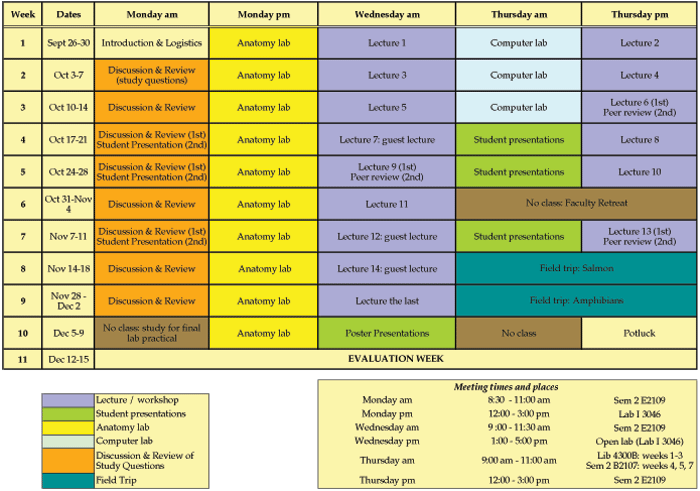
Announcements, Schedule & FAQs |
| Down to Schedule | Down to FAQs |
Announcements

Announcements, Schedule & FAQs |
| Down to Schedule | Down to FAQs |
Society for Northwestern Vertebrate Biology, Student Scholarship Announcement (due January 15).Remaining schedule (updated Dec 7):
- Evaluation week: All evaluations will be done by Tuesday, Dec 13. Eval schedule downloadable here.
- Come to your eval conference prepared with both your self-evaluation and your faculty evaluation (or hand them in to Pam Udovich, the program secretary). Also, please arrive ten minutes early in order to pick up your portfolio and poster, and read my evaluation of you (which will be inside, as well as your graded lab practicals, and any other work that I had yet to return to you) before our conference.
Q: Is Vertebrate Evolution upper-division?
A: Yes! Students who do consistently high-quality work will receive 16 upper-division science credits,
likely in evolutionary biology, vertebrate anatomy and physiology, and philosophy of science.
Q: I was really interested in the year-long program, Evolution: Patterns and Processes. How similiar is this
program going to be?
A: Because this is a one-quarter, single-faculty program, we won't be covering nearly as much ground as was planned
for Evolution. We won't be delving into genetics or development, and will spend little time on microevolution (aka
evolutionary ecology). This program will give you a solid background in macroevolution (aka origin of species), however,
through lectures, anatomy labs, and computer labs, in which we learn how to build evolutionary trees. In addition, the
focus will be on vertebrates, and roughly half of the time in the classroom will comprise a survey of vertebrate zoology,
including what anatomical and physiological characters distinguish the major groups of vertebrates.
Q: How will you be assessing student work in this program?
A: I will be evaluating your work (your rigor, intellectual curiosity, and comprehension) in several ways. While this is
not a final list, these are likely to include:
Q: I'm interested in the program, but don't believe in dissecting animals. Can I opt out of the anatomy lab?
A: No. The anatomy lab will be an integral part of the program--you need to be prepared to take the full 16 credits,
or find an alternate program. That said, we will not be dissecting any wild-caught animals (which is why we will probably
not be dissecting sharks, even though they are the standard example of a "basal vertebrate" in most comparative anatomy
labs). The cats that we will be dissecting were euthanized by Humane Societies across the U.S., then collected by
biological supply companies for prep for use in classroom settings. They were not killed for use in the lab. Finally,
dissection of organisms is the best way to fully understand the diversity between both individuals and species, and having
respect for the organisms that we dissect is imperative in an anatomy lab. If, despite these considerations, you are
unwilling to participate in dissections for six weeks of the quarter, you should look for another program.
Q: Only six weeks? What will the remaining anatomy labs consist of?
A: We will spend three weeks comparing skulls from a variety of vertebrates (almost all of which
are reproductions of actual skulls, not real bone). And there will be a final lab practical in week 10 as well.
Q: Week 10? Didn't you say it was week 9 before? My calendar says Monday of week 9 is the Monday after Thanksgiving.
Have you no heart?
A: After carefully considering this question for a while, I've decided that we won't have class during Thanksgiving week.
That does mean, however, that you'll have to come back from Thanksgiving ready for a lot of work in the last two weeks of
class.
Q: Will there be any field component of the program?
A: There will be two all-program field trips, not three as advertised earlier: two day trips late in the quarter,
to Kennedy Creek to see the salmon run, and somewhere else relatively local to see the beginning of amphibian breeding
behavior in late November/early December. We are NOT going to go on a multi-day trip to Eastern Washington
early in the quarter.
